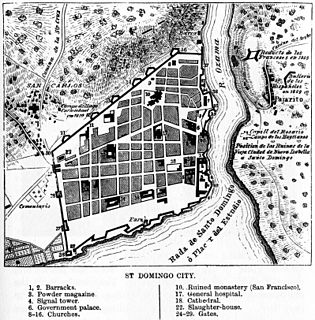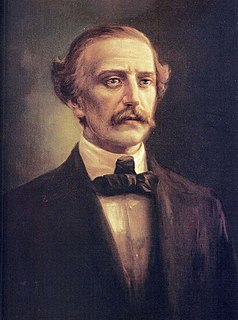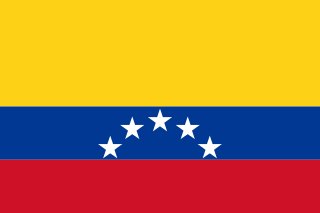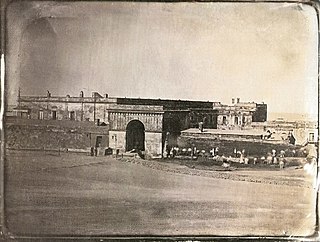| UNESCO World Heritage site | |
|---|---|
 | |
| Location | Santo Domingo, Dominican Republic |
| Part of | Colonial City of Santo Domingo |
| Criteria | Cultural: (ii), (iv), (vi) |
| Reference | 526 |
| Inscription | 1990 (14th Session) |
| Coordinates | 18°28′17″N69°53′30″W / 18.471500000015°N 69.891550000056°W Coordinates: 18°28′17″N69°53′30″W / 18.471500000015°N 69.891550000056°W |


La Puerta del Conde (The Count's Gate) was the main entrance to the fortified city of Santo Domingo (in present-day Dominican Republic), named to honor Governor Captain-General Bernardino de Meneses Bracamonte y Zapata, 1st Count of Peñalva, who during his tenure saved the city from a siege in 1655 by Englishmen General Robert Venables and Admiral William Penn amid the Third Anglo-Spanish War.

The Dominican Republic is a country located in the island of Hispaniola, in the Greater Antilles archipelago of the Caribbean region. It occupies the eastern five-eighths of the island, which it shares with the nation of Haiti, making Hispaniola one of two Caribbean islands, along with Saint Martin, that are shared by two sovereign states. The Dominican Republic is the second-largest Caribbean nation by area at 48,671 square kilometers (18,792 sq mi), and third by population with approximately 10 million people, of which approximately three million live in the metropolitan area of Santo Domingo, the capital city.
Bernardino de Meneses Bracamonte, 1st Count de Peñalva was a Spanish nobleman and military leader during the Anglo-Spanish War (1654). He participated in the Siege of Santo Domingo (1655) and was victorious over the English forces.
The Siege of Santo Domingo was fought between April 23, 1655 and April 30, 1655, at the Spanish Colony of Santo Domingo. A force of 2,400 Spanish troops led by Governor Don Bernardino Meneses y Bracamonte, Count of Peñalba successfully resisted a force of 13,120 soldiers led by General Robert Venables and 34 ships under Admiral Sir William Penn of the English Commonwealth.
Contents
- History
- Colonial era
- Contemporary Dominican Republic
- Parque Independencia
- Altar de la Patria
- See also
- References
The gate is part of a structure called El Baluarte del Conde (The Count's Bulwark), a fort in Ciudad Colonial, the colonial area of Santo Domingo. The fort was part of a larger system of fortifications that ran along a defensive wall which surrounded Ciudad Colonial. The Altar of the Fatherland and Independence Park are located there.

Ciudad Colonial is the historic central neighborhood of Santo Domingo and the oldest permanent European settlement of the Americas. It has been declared a World Heritage Site by UNESCO. It is also known as Zona Colonial or more colloquially as "La Zona". The Ciudad Colonial is located on the west bank of the Ozama River, which bisects the city. It covers 1.06 km2 (0.41 sq mi) bounded by a walled perimeter.

A defensive wall is a fortification usually used to protect a city, town or other settlement from potential aggressors. In ancient to modern times, they were used to enclose settlements. Generally, these are referred to as city walls or town walls, although there were also walls, such as the Great Wall of China, Walls of Benin, Hadrian's Wall, Anastasian Wall, the Cyclopean Wall Rajgir and the metaphorical Atlantic Wall, which extended far beyond the borders of a city and were used to enclose regions or mark territorial boundaries. In mountainous terrain, defensive walls such as letzis were used in combination with castles to seal valleys from potential attack. Beyond their defensive utility, many walls also had important symbolic functions – representing the status and independence of the communities they embraced.

El Altar de la Patria, or The Altar of the Homeland, is a white marble mausoleum in Santo Domingo, Dominican Republic that houses the remains of the founding fathers of the Dominican Republic: Juan Pablo Duarte, Francisco del Rosario Sánchez, and Ramón Matías Mella, collectively known as Los Trinitarios. Within the mausoleum there are statues of the founding fathers, carved by Italian sculptor Nicholas Arrighini; there is as well an "eternal flame" that is kept lit in memory of the patriots. The Altar is within the Baluatre del Conde and is the main attraction of the Parque Independencia.
Francisco del Rosario Sánchez, one of the Dominican Founding Fathers, proclaimed Dominican independence and raised the first Dominican Flag, on February 27, 1844. [1]

Francisco del Rosario Sánchez was a politician, national hero and founding father of the Dominican Republic. He is considered by Dominicans as the second leader of the 1844 Dominican War of Independence, after Juan Pablo Duarte and before Matías Ramón Mella. The Order of Merit of Duarte, Sanchez and Mella is named in honor of these men. He was the son of Olaya del Rosario Belén (1791–1849), a white woman of Canarian descent, and Narciso Sánchez Ramona (1789–1869), a pardo (triracial) man; his surnames are inverted because his parents were not married at the time of his birth, marrying in 1819.

The Dominican Independence War gave the Dominican Republic autonomy from Haiti on February 27, 1844. Before the war, the island of Hispaniola had been united under the Haitian government for a period of 22 years when the newly independent nation, previously known as the Captaincy General of Santo Domingo, was unified with Haiti in 1822. The criollo class within the country overthrew the Spanish crown in 1821 before unifying with Haiti a year later.

The flag of the Dominican Republic represents the Dominican Republic and, together with the coat of arms and the national anthem, has the status of national symbol. The blue on the flag stands for liberty, the white for salvation, and the red for the blood of heroes. The civil ensign follows the same design, but without the charge in the center. The flag was designed by Juan Pablo Duarte.










